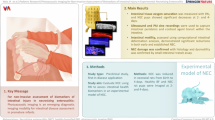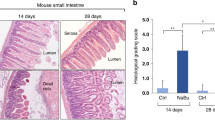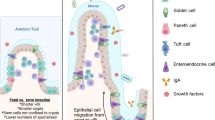Abstract
We tested the hypothesis that inducible isoform of nitric oxide synthase (iNOS)-derived nitric oxide (NO) inhibits oxygen consumption (Vo2) in human intestine resected for necrotizing enterocolitis (NEC). Each NEC resection specimen was divided into two sections based on histologic appearance: healthy or diseased. Intestine removed from infants for reasons other than NEC was used as control. The tissue injury score (0–6, with 6 indicating complete necrosis) was 0.4 ± 0.2 in control tissue, 1.2 ± 0.4 in NEC-healthy tissue, and 4.6 ± 0.5 in NEC-diseased tissue. Prominent iNOS staining was present in villus enterocytes in NEC-healthy tissue but not in the other tissue types. Intestinal Vo2 (per direct oximetry, in nM O2/min/g) was significantly greater in control tissue than in NEC-healthy or NEC-diseased tissues. Accumulation of NO into buffer bathing intestinal slices (in nM NO/μL/g) was greater in NEC-healthy tissue than control or NEC-diseased tissues. The specific iNOS antagonist l-Nω-(1-iminoethyl)-lysine (l-NIL) reduced buffer NO concentration 76% and increased Vo2 by 90% in NEC-healthy tissue; however, l-NIL had no effect on NO or Vo2 in control or NEC-diseased tissue. Addition of exogenous NO via S-nitroso-N-acetylpenicillamine depressed Vo2 in NEC-healthy and control tissues but not NEC-diseased tissue. A significant correlation was present between buffer NO concentration and Vo2 in NEC-healthy tissue. We conclude that iNOS-derived NO suppresses Vo2 in intestine resected for NEC that demonstrates a relatively normal histology on light microscopy.
Similar content being viewed by others
Log in or create a free account to read this content
Gain free access to this article, as well as selected content from this journal and more on nature.com
or
Abbreviations
- DNP:
-
2,4-dinitrophenol
- eNOS:
-
endothelial nitric oxide synthase
- l-NIL:
-
l-Nω-(1-iminoethyl)-lysine
- l-NNA:
-
l-NG-nitroarginine
- NEC:
-
necrotizing enterocolitis
- SNAP:
-
S-nitroso-N-acetylpenicillamine
- SP:
-
substance P
- Vo2:
-
oxygen consumption
References
Ford H, Watkins S, Reblock K, Rowe M 1997 The role of inflammatory cytokines and nitric oxide in the pathogenesis of necrotizing enterocolitis. J Pediatr Surg 32: 75–282
Nadler EP, Dickinson E, Knisley A, Zhang XR, Boyle P, Beer-Stolz D, Watkins SC, Ford HR 2000 Expression of inducible nitric oxide synthase and interleukin-12 in experimental necrotizing enterocolitis. J Surg Res 92: 1–77
Hierholzer C, Kalff JC, Billiar TR, Bauer AJ, Tweardy DJ, Harbrecht BG 2004 Induced nitric oxide promotes intestinal inflammation following hemorrhagic shock. Am J Physiol Gastrointest Liver Physiol 286: 225–G233
Dickinson E, Tuncer R, Nadler E, Boyle P, Alber S, Watkins S, Ford H 1999 NOX, a novel nitric oxide scavenger, reduces bacterial translocation in rats after endotoxin challenge. Am J Physiol 277: 1281–G1287
Suzuki Y, Deitch EA, Mishima S, Lu Q, Xu D 2000 Inducible nitric oxide synthase gene knockout mice have increased resistance to gut injury and bacterial translocation after an intestinal ischemia-reperfusion injury. Crit Care Med 28: 692–3696
Deitch EA, Shorshtein A, Houghton J, Lu Q, Xu D 2002 Inducible nitric oxide synthase knockout mice are resistant to diet-induced loss of gut barrier function and intestinal injury. J Gastrointest Surg 6: 99–605
Rachmilewitz D, Stamler JS, Bachwich D, Karmeli F, Ackerman Z, Podolsky DK 1995 Enhanced colonic nitric oxide generation and nitric oxide synthase activity in ulcerative colitis and Crohn's disease. Gut 36: 18–723
Kankuri E, Hamalainen M, Hukkanen M, Salmenpera P, Kivilaakso E, Vapaatalo H, Moilanen E 2003 Suppression of pro-inflammatory cytokine release by selective inhibition of inducible nitric oxide synthase in mucosal explants from patients with ulcerative colitis. Scand J Gastroenterol 38: 86–192
Cleeter MW, Cooper JM, Darley-Usmar VM, Moncada S, Schapira AH 1994 Reversible inhibition of cytochrome c oxidase, the terminal enzyme of the mitochondrial respiratory chain, by nitric oxide. Implications for neurodegenerative diseases. FEBS Lett 345: 0–54
Loke KE, McConnell PI, Tuzman JM, Shesely EG, Smith CJ, Stackpole CJ, Thompson CI, Kaley G, Wolin MS, Hintze TH 1999 Endogenous endothelial nitric oxide synthase-derived nitric oxide is a physiological regulator of myocardial oxygen consumption. Circ Res 84: 40–845
Laycock SK, Vogel T, Forfia PR, Tuzman J, Xu X, Ochoa M, Thompson CI, Nasjletti A, Hintze TH 1998 Role of nitric oxide in the control of renal oxygen consumption and the regulation of chemical work in the kidney. Circ Res 82: 263–1271
Wolin MS, Hintze TH, Shen W, Mohazzab -HKM, Xie YW 1997 Involvement of reactive oxygen and nitrogen species in signalling mechanisms that control tissue respiration in muscle. Biochem Soc Trans 25: 34–939
Nowicki PT 1998 Postnatal changes in gut hemodynamics: a possible role for substance P. Am J Physiol 274: G1142–G1150
Potoka DA, Nadler EP, Zhou X, Zhang XR, Upperman JS, Ford HR 2000 Inhibition of NF-kappaB by IkappaB prevents cytokine-induced NO production and promotes enterocyte apoptosis in vitro. Shock 14: 366–373
Furfine ES, Harmon MF, Paith JE, Garvey EP 1993 Selective inhibition of constitutive nitric oxide synthase by L-NG-nitroarginine. Biochemistry 32: 8512–8517
Zhang JY, Wang Y, Milton MN, Kraus L, Breau AP, Paulson SK 2004 Disposition and pharmacokinetics of L-N6-(1-iminoethyl)lysine-5-tetrazole-amide, a selective iNOS inhibitor, in rats. J Pharm Sci 93: 1229–1240
Xie YW, Shen W, Zhao G, Xu X, Wolin MS, Hintze TH 1996 Role of endothelium-derived nitric oxide in the modulation of canine myocardial mitochondrial respiration in vitro. Implications for the development of heart failure. Circ Res 79: 381–387
Nowicki PT, Miller CE 1993 Regulation of capillary exchange capacity in postnatal swine intestine. Am J Physiol 265: G1090–G1097
Reber KM, Mager GM, Miller CE, Nowicki PT 2001 Relationship between flow rate and NO production in postnatal mesenteric arteries. Am J Physiol Gastrointest Liver Physiol 280: G43–G50
Book LS, Overall JC Jr Herbst JJ, Britt MR, Epstein B, Jung AL 1977 Clustering of necrotizing enterocolitis. Interruption by infection-control measures. N Engl J Med 297: 984–986
Sommerschild HC 1971 Intestinal perforation in the newborn infant as a complication in umbilical vein infusion or exchange transfusion. Surgery 70: 609–613
Koivisto A, Matthias A, Bronnikov G, Nedergaard J 1997 Kinetics of the inhibition of mitochondrial respiration by NO. FEBS Lett 417: 75–80
Bohlen HG 1998 Mechanism of increased vessel wall nitric oxide concentrations during intestinal absorption. Am J Physiol 275: H542–H550
Shen W, Hintze TH, Wolin MS 1995 Nitric oxide. An important signaling mechanism between vascular endothelium and parenchymal cells in the regulation of oxygen consumption. Circulation 92: 3505–3512
Bohlen HG 1980 Intestinal mucosal oxygenation influences absorptive hyperemia. Am J Physiol 239: H489–H493
Ballance WA, Dahms BB, Shenker N, Kliegman RM 1990 Pathology of neonatal necrotizing enterocolitis: a ten year experience. J Pediatr 117: S6–S13
Beltrán B, Mathur A, Duchen MR, Erusalimsky JD, Moncada S 2000 The effect of nitric oxide on cell respiration: a key to understanding its role in cell survival or death. Proc Natl Acad Sci U S A 97: 14602–14607
Widdowson EM 1985 Development of the digestive system: comparative animal studies. Am J Clin Nutr 41: 384–390
Reber KM, Nankervis CA, Nowicki PT 2002 Newborn intestinal circulation. Physiology and pathophysiology. Clin Perinatol 29: 23–39
MacKendrick W, Caplan M, Hsueh W 1993 Endogenous nitric oxide protects against platelet-activating factor-induced bowel injury in the rat. Pediatr Res 34: 222–228
Caplan MS, Sun XM, Hseuh W, Hageman JR 1990 Role of platelet activating factor and tumor necrosis factor-alpha in neonatal necrotizing enterocolitis. J Pediatr 116: 960–964
Becker RM, Wu G, Galanko JA, Chen W, Maynor AR, Bose CL, Rhoads JM 2000 Reduced serum amino acid concentrations in infants with necrotizing enterocolitis. J Pediatr 137: 785–793
Zamora SA, Amin HJ, McMillan DD, Kubes P, Fick GH, Butzner JD, Parsons HG, Scott RB 1997 Plasma L-arginine concentrations in premature infants with necrotizing enterocolitis. J Pediatr 131: 226–232
Amin HJ, Zamora SA, McMillan DD, Fick GH, Butzner JD, Parsons HG, Scott RB 2002 Arginine supplementation prevents necrotizing enterocolitis in the premature infant. J Pediatr 140: 425–431
Neu J 2002 Arginine supplementation and the prevention of necrotizing enterocolitis in very low birth weight infants. J Pediatr 140: 389–391
Rhoads JM, Chen W, Gookin J, Wu GY, Fu Q, Blikslager AT, Rippe RA, Argenzio RA, Cance WG, Weaver EM, Romer LH 2004 Arginine stimulates intestinal cell migration through a focal adhesion kinase dependent mechanism. Gut 53: 514–522
Author information
Authors and Affiliations
Corresponding author
Additional information
This work was funded by National Institutes of Health Grant DK 065306 (P.T.N.)
Rights and permissions
About this article
Cite this article
Nowicki, P., Reber, K., Giannone, P. et al. Intestinal O2 Consumption in Necrotizing Enterocolitis: Role of Nitric Oxide. Pediatr Res 59, 500–505 (2006). https://doi.org/10.1203/01.pdr.0000203094.27615.5f
Received:
Accepted:
Issue date:
DOI: https://doi.org/10.1203/01.pdr.0000203094.27615.5f
This article is cited by
-
Incomplete resection of necrotic bowel may increase mortality in infants with necrotizing enterocolitis
Pediatric Research (2021)
-
Does red blood cell irradiation and/or anemia trigger intestinal injury in premature infants with birth weight ≤ 1250 g? An observational birth cohort study
BMC Pediatrics (2018)



